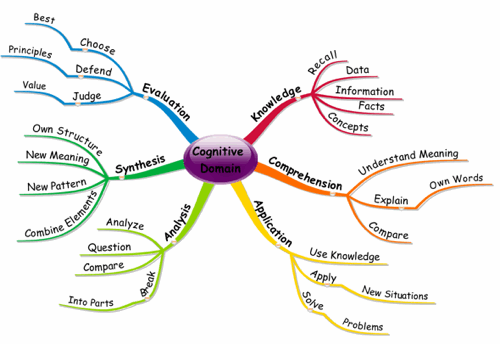Mind Map of Bloom's Taxonomy - The Cognitive Domain

Subscribe to Using Mind Maps
Get Access to the Best Mind Mapping Tips, Tools, Techniques Resources and Opinions.
Bloom's Taxonomy is the most well-known for the work done in the Cognitive Domain. This is the second domain covered in the four part Study Skills and Bloom's Taxonomy series. The first domain, the Affective Domain, was covered in the previous article and the next article will cover the Psychomotor Domain.
Skills in the cognitive domain revolve around knowledge, comprehension, and critical thinking of a particular topic. Traditional education tends to emphasize the skills in this domain, particularly the lower-order objectives. Most study skills training will therefore be focused on enhancing this domain.
According to Wikipedia, the online Encyclopedia, a great mythology has grown around the Taxonomy. I hope this article will take away some of the mysticism around the topic by reducing the principles to simple examples and seeing them holistically in a Mind Map.
The categories in the Cognitive Domain go from the lowest order to the highest order of human thinking. Many believe that each step must be mastered before you can move on to the next step. The jury is still out on this one.
I believe that by Using Mind Maps you naturally explore and apply each of the categories in this domain.
I will also tie each of the levels into Mind Mapping by using the Mind Map Principles and the seven steps in creating a Mind Map as a case study.
1. Knowledge
The knowledge category simply applies to the ability to recall what has been learned. The recall of dates, information, facts and even concepts is seen as a lower order skill, even though it is often the most emphasised when teaching study skills.
Traditional education has mostly focused on the ability to recall information, but in recent years most countries' education systems have moved to something that resembles Bloom's taxonomy of the Cognitive Domain.
What must not be forgotten when 'moving up the ladder' is that the ability to recall information is the foundation upon which the other categories are built. A common error is to move onto the higher levels without first mastering the ability to recall information. This is particularly dangerous if this step is skipped in the formative years of a child's life.
Example: List the Mind Map Principles and the seven steps in creating a Mind Map.
2. Comprehension
You should be able to demonstrate your understanding of the subject matter. This is best done by explaining in your own words, or comparing to something else.
Example: Explain the Mind Mapping Principles in your own words. Compare the Mind Mapping principles to the Seven Steps in creating a Mind Map.
3. Application
Applying what you have learnt in a new situation or in solving a problem.
Example: Create a Mind Map summary of a book, or chapter of a book, using the Mind Map Principles and the Seven Steps in creating a Mind Map.
4. Analyze
Breaking up the information into parts, comparing, questioning and analyzing. Distinguish between facts and inferences.
Example: Rank the Mind Map principles in order of importance with reasons, based on the relative benefit of each principle. Which benefits are absolutely necessary and why? Which are not necessary and why not?
5. Synthesis
Combining the elements learned and perhaps forming a new pattern, new meaning or new structure.
Example: Use the Seven Steps in creating a Mind Map to combine various sources into one cohesive Mind Map, while blending the thoughts of the original authors with that of your own.
6. Evaluation
Judge the value of what you have learned, defend the principles and choose the best option when applying the principles. Evaluate whether you should use the new found knowledge in a situation, or whether you old know would suffice.
Example: Decide which steps or principles your are going to use or discard when creating a Mind Map. Introduce your own principles where necessary. Combine linear notes with Mind Maps when taking notes.
Conclusion
Mind Maps naturally allow you use each of these thinking skills when learning or thinking. A Mind Map enables you to see the big picture as well as the individual parts. The branches naturally allow you to easily compare one branch to another. You can easily combine your own thoughts with that of the original author and you can easily generate new thoughts or solve problems by using Mind Maps.
We have put together a Learning Management Program that utilizes Mind Maps and therefore Bloom's taxonomy in the delivery of the material and your practical application of the material. You first learn the knowledge and skills and then you apply it before you adapt it to your own needs.
I hope that this brief introduction to the Cognitive Domain encourages you to read further on the subject and therefore improve your study skills.
Return from Study Skills - Cognitive Domain to Study Skills and Blooms Taxonomy
Return from Study Skills - Cognitive Domain to Using Mind Maps Home Page



